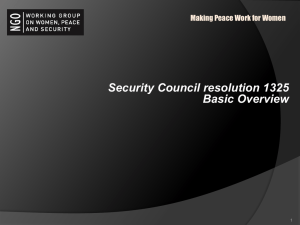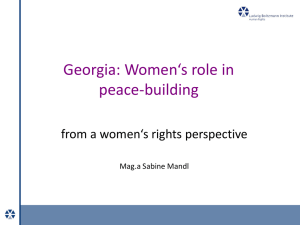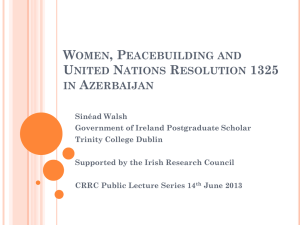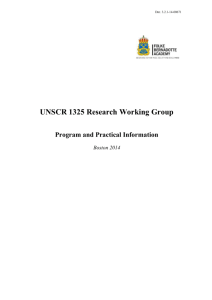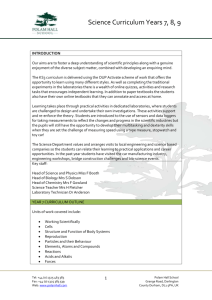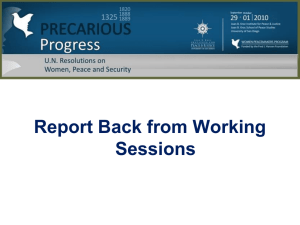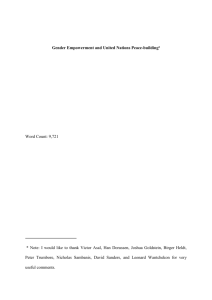SCR 1325
advertisement
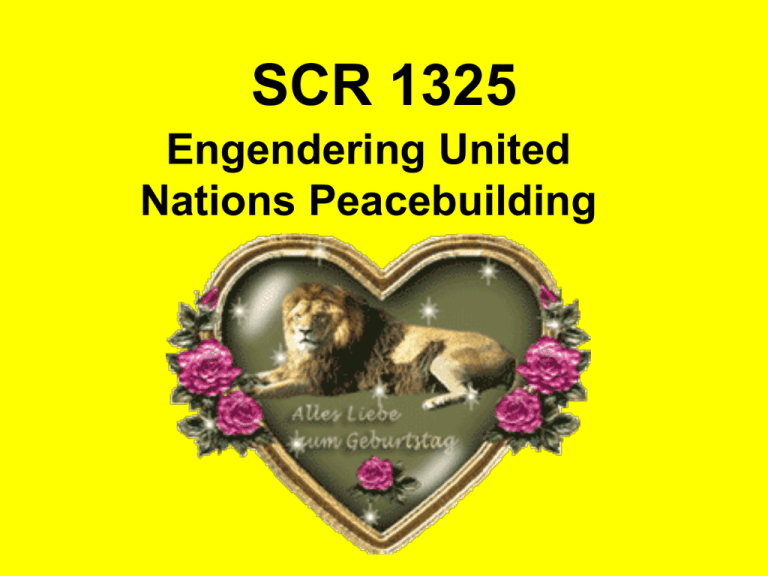
SCR 1325 Engendering United Nations Peacebuilding SCR 1325 Background I • Peace-building has become a major industry in international institutions. • While once the international community aimed simply to maintain a ceasefire and restore some form of stability in conflict zones, since the early 1990s there has been increasing attention given to creating peaceful and democratic societies through international intervention. • Examples of peace-building exercises include Cambodia, Bosnia, Kosovo, East Timor, Afghanistan,Sierra Leone and Iraq. • The significance of peace-building on the international agenda is emphasised by the joint establishment by the General Assembly and Security Council of a UN Peacebuilding Commission in December 2005. The Commission is a 31member intergovernmental body whose functions will be to develop strategic policy and to monitor, coordinate and evaluate UN peace-building activities. SCR 1325 Background II • Peace-building was defined by UN Secretary-General Boutros Boutros-Ghali in 1993 as • ‘action to identify and support structures which will tend to strengthen and solidify peace in order to avoid a relapse into conflict’. • He envisioned peace-building measures such as • disarmament, restoring order, the custody and possible destruction of weapons, • repatriation of refugees, support for security personnel, • election monitoring, human rights protection, reforming or strengthening of governmental institutions • and promoting formal and informal processes of political participation. SCR 1325 Background III • In 1998 UN Secretary-General Kofi Annan adopted a similar statement but added the task of • ‘providing for reintegration and rehabilitation programmes, and creating conditions for resumed development’. • This encompassed • sociopolitical and economic reconstruction of societies, including power sharing, plus • establishing constitutional, administrative and legal structures and determining resource allocation. • In addition peace-building was understood to include the physical reconstruction of a society houses, roads, schools, electricity, sewage, hospitals and other infrastructure. Literaturtipp Building Women into Peace: the international legal framework CHRISTINE CHINKIN & HILARY CHARLESWORTH • Third World Quarterly, Vol. 27, No. 5, pp 937 – 957, 2006 SCR 1325 Background IV One striking omission from these accounts was the impact on women and their role in the processes of peace-building. • In 2000 the Special Session of the UN General Assembly reviewing the progress of the outcomes of the Fourth World Conference on Women, Beijing, emphasised the need to ensure women’s participation throughout • ‘all levels of decision-making and implementation in development activities and peace processes’. The value of women’s participation in the prevention and resolution of conflicts and in peace-building was reinforced later that year in Security Council Resolution 1325 on Women, Peace and Security. SCR 1325 Background V SCR 1325 called for the inclusion of a ‘gender perspective’ in post-conflict settlements, • ‘including the special needs of women and girls during repatriation and resettlement and for rehabilitation, reintegration and post-conflict reconstruction’. SCR 1325 also endorsed • 'measures that ensure the protection of and respect for human rights of women and girls, particularly as they relate to the constitution, the electoral system, the police and the judiciary’. SCR 1325 Background VI • Security Council Resolution 1325 endorses two separate policies in the design and implementation of post-conflict reconstruction: • ‘gender balance’ in participation throughout all processes for decision making, policy making and operationalising measures for post-conflict peace-building; • and ‘gender mainstreaming’ in the formulation of all peace-building policies, practices and law and in their implementation. Elements of conflict and possible gender dimensions Political negotiations and planning to implement peace accords: Men’s and women’s participation in these processes tends to vary, with women often playing only minor roles in formal negotiations or policy making. Media used to communicate messages (peace accords, etc.): Women’s unequal access to media may mean that their interests, needs, and perspectives are not represented and discussed. Use of outside investigators, peacekeepers, etc.: Officials are not generally trained in gender equality issues (women’s rights as human rights, how to recognize and deal with gender-specific violence). Women and girls have been harassed and sexually assaulted by peacekeepers. Holding of elections: Women face specific obstacles in voting, in standing for election and in having gender equality issues discussed as election issues. International investment in employment creation, health care, etc.: Reconstruction programmes may not recognize or give priority to supporting women’s and girls health needs, domestic responsibilities or need for skills and credit. . Literaturtipp The scope of Resolution 1325 has been analysed in two major studies: one prepared by the UN Secretariat and one prepared by the United Nations Development Fund For Women (UNIFEM). These documents contain detailed recommendations on the implementation of the Resolution and are a valuable resource for peace-building operations. • Women, Peace and Security, Study Submitted by the SecretaryGeneral Pursuant to Security Council Resolution 1325 (2000), United Nations, 2002, at http://www.un.org/womenwatch/daw/public/eWPS.pdf. • E Rehn & E Johnson Sirleaf, Women, War and Peace: The Independent Experts’ Assessment on the Impact of Armed Conflict on Women and Women’s Role in Peace-building, New York: UNIFEM, 2002. Mehr Literatur… • http://www.wilpfinternational.org/public ations/index.htm • http://www.peacewomen.org/themes_th eme.php?id=15&subtheme=true Schönen Abend noch…
